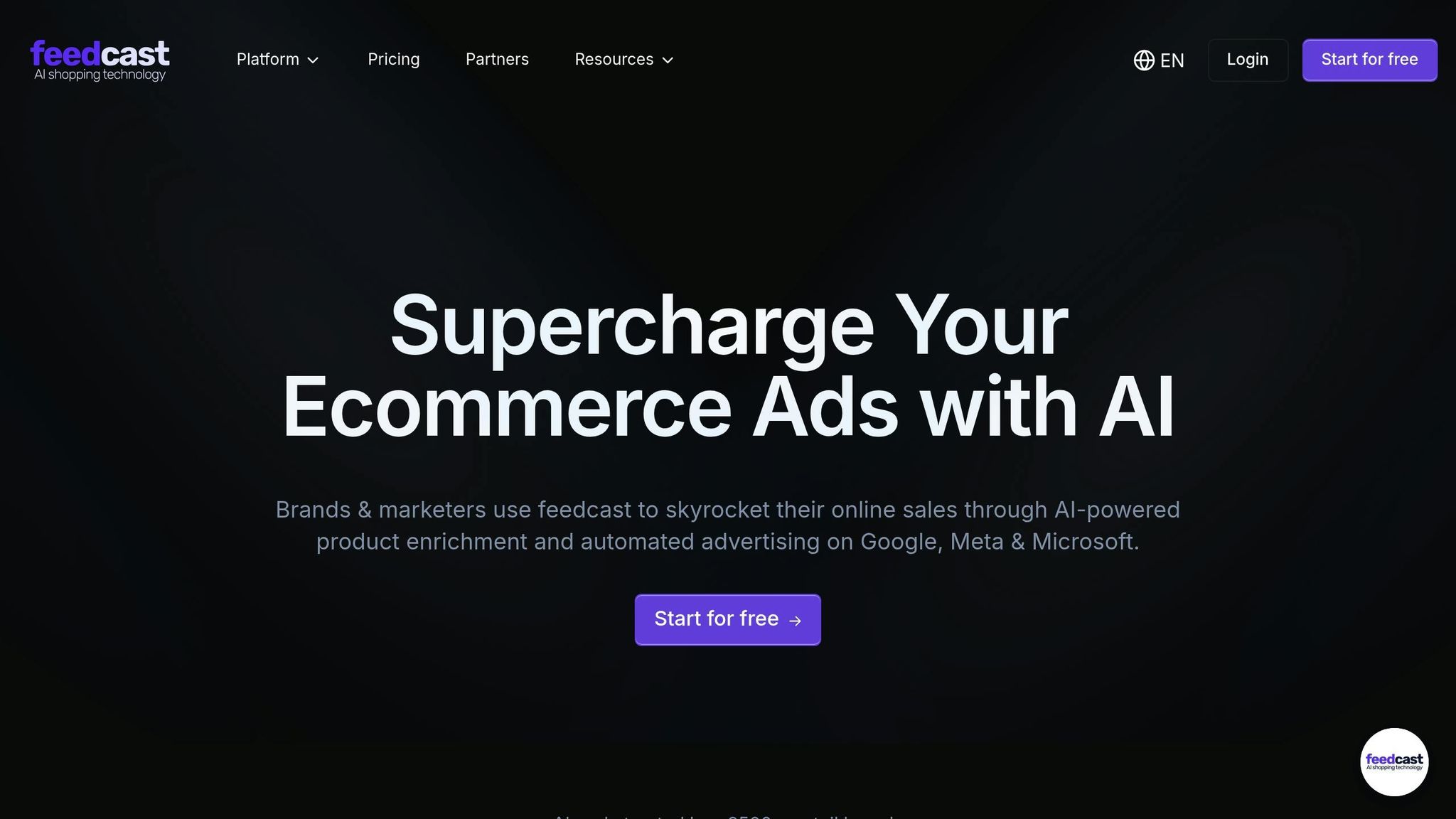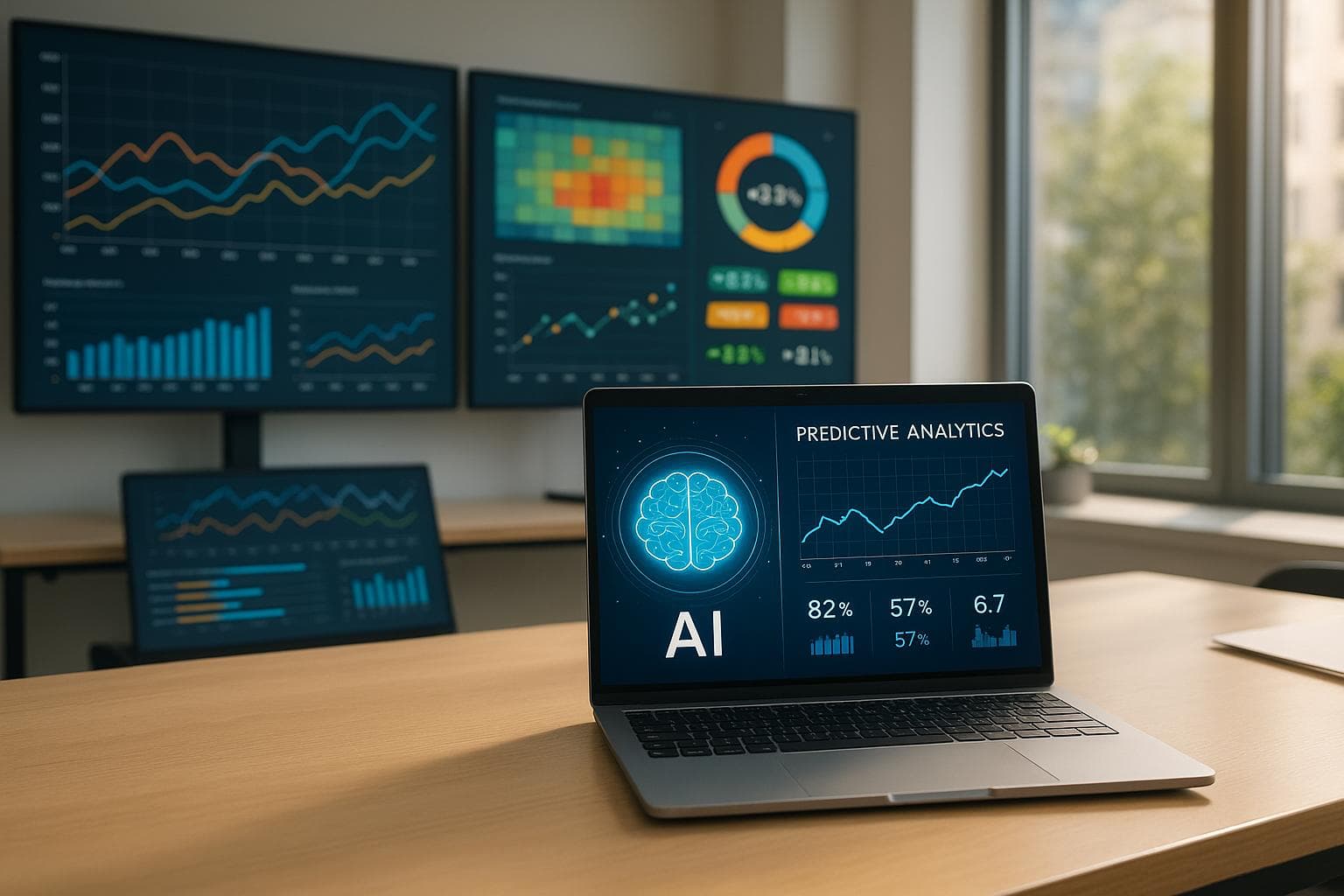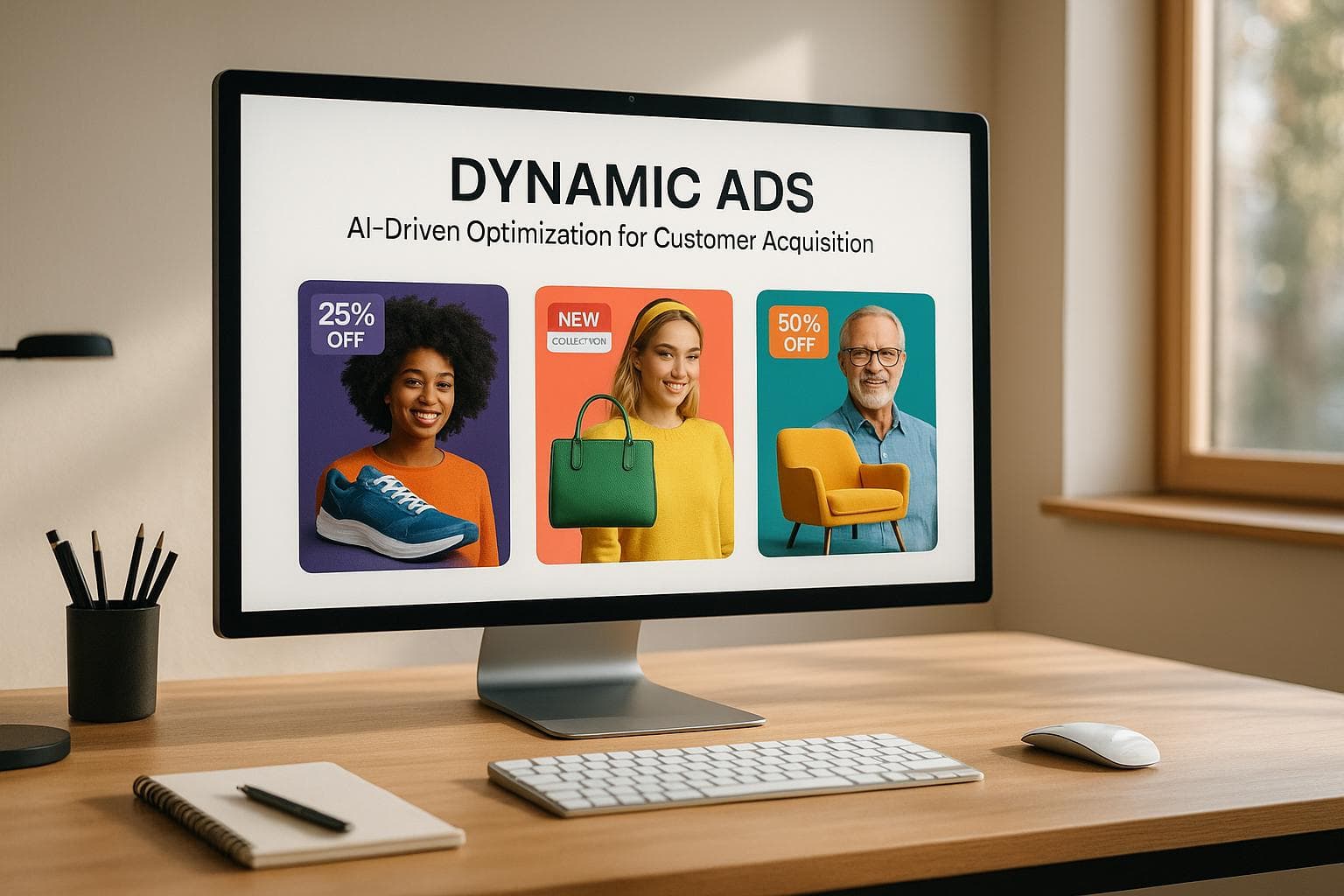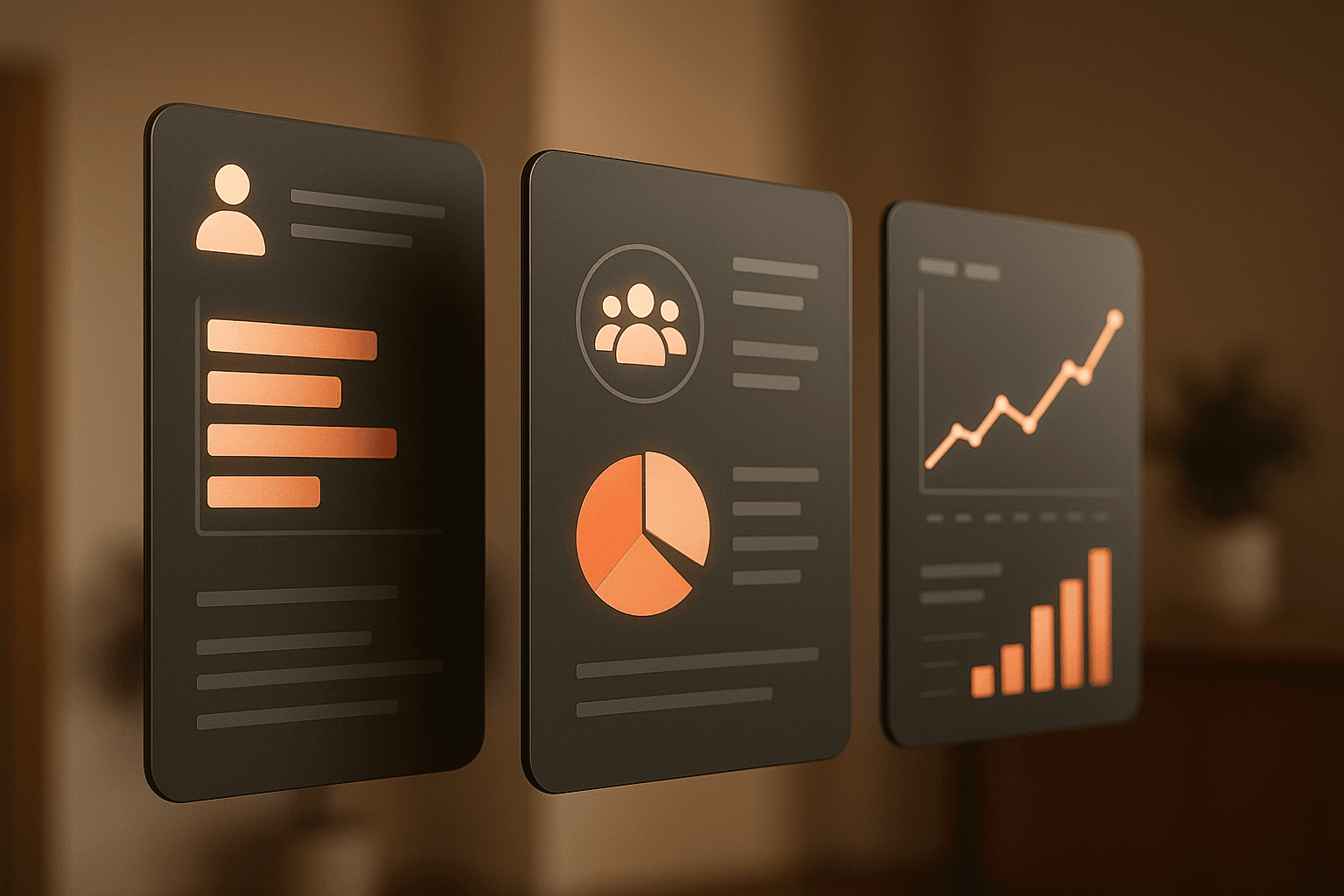How AI Improves Abandoned Cart Retargeting
AI transforms abandoned cart retargeting through real-time personalization and predictive analytics, boosting conversion rates and customer engagement.
70% of online shopping carts are abandoned, costing businesses $260 billion annually in lost revenue. AI-powered retargeting is changing the game by addressing this issue with smarter, faster, and more personalized solutions. Here's how:
- Real-Time Interventions: AI predicts potential cart abandoners and engages them instantly with tailored messages, unlike delayed traditional methods.
- Personalized Campaigns: By analyzing customer behavior and demographics, AI crafts messages that directly address individual hesitations, boosting conversions.
- Multi-Channel Reach: AI automates retargeting across platforms like Google, Facebook, Instagram, and SMS, ensuring consistent customer engagement.
- Proven Results: Companies using AI report up to 8x return on marketing spend, with businesses like Samsung and Sephora reducing cart abandonment by 24% and recovering 20% more carts, respectively.
AI isn't just about recovering carts - it transforms how businesses connect with customers, driving higher retention and revenue growth.
How AI Fixes Cart Abandonment Fast
AI-Powered Retargeting Campaigns
AI has revolutionized retargeting, turning it into a proactive system that connects with customers across various channels with pinpoint accuracy. Instead of waiting for customers to leave, AI identifies potential abandoners and engages them with tailored messages addressing their specific needs or hesitations.
Automated Multi-Channel Retargeting
Today’s AI tools automatically launch retargeting campaigns across platforms like Google, Facebook, Instagram, and SMS, ensuring brands maintain a consistent presence wherever their customers interact.
But AI doesn’t just automate - it adapts. By analyzing customer behavior in real time, it adjusts ad strategies to match individual shopping habits. For instance, if a shopper lingers on a product page or hesitates at checkout, AI can instantly trigger personalized campaigns across all connected platforms.
SMS plays a standout role in this strategy, boasting open rates close to 98%[2]. AI ensures these messages are sent at the perfect moment and through the most effective channel to maximize conversions.
A great example comes from Rapha Racing. By implementing AI-driven, personalized ad targeting, they saw a 31% spike in purchase events within just an hour[2]. This showcases the power of combining automation with precision.
Using Behavioral and Demographic Data
AI doesn’t just stop at automating campaigns - it takes targeting to the next level by analyzing both behavioral data (like browsing patterns and purchase history) and demographic details (such as age, location, and income). This dual-layer approach allows for campaigns that are finely tuned to both who the customer is and how they behave online[4].
The results speak for themselves: companies leveraging behavioral insights see an 85% boost in sales growth and a 25% improvement in gross margins compared to their peers[4]. AI achieves this by processing vast amounts of data, including page views, email interactions, social media activity, and buying trends[5].
"Organizations that leverage customer behavioral insights outperform peers by 85% in sales growth and more than 25% in gross margin." – McKinsey & Company[4]
Unlike static demographic categories, AI creates dynamic customer segments that evolve as behaviors shift[8]. For example, Orbitz discovered that Mac users spend up to 30% more per night on hotels than PC users, enabling them to target this group with higher-end accommodation options[4].
Yves Rocher also demonstrated the power of AI-driven data analysis. By using AI to recommend products in real time, they achieved an 11x higher purchase rate compared to generic top-seller recommendations[2].
These personalized approaches matter: 67% of shoppers say personalized product recommendations influence their decision to buy[2]. AI uncovers patterns traditional methods often miss, opening up new opportunities for engagement[7].
AI vs Traditional Retargeting Comparison
Here’s a side-by-side look at how AI-driven retargeting stacks up against traditional methods:
| Feature | Traditional Retargeting | AI-Powered Retargeting |
|---|---|---|
| Response Time | Hours to days after abandonment | Real-time actions during browsing |
| Personalization | Generic messages and offers | Tailored content based on behavior |
| Channel Management | Manual setup across platforms | Automated multi-channel coordination |
| Customer Segmentation | Basic demographic categories | Dynamic behavioral and psychographic segments |
| Message Optimization | Static templates | Adaptive, data-driven content |
| Scalability | Limited by manual effort | Fully automated and scalable |
| ROI | Standard email conversion rates | 5-8x return on marketing spend[2] |
Traditional retargeting often depends on generic cart abandonment emails, lacking the immediacy and personalization that today’s customers expect[1]. AI, on the other hand, steps in proactively, identifying customers likely to abandon their carts and engaging them before they leave[2].
This shift from reactive to proactive strategies is a game-changer. AI-driven retargeting campaigns are 60% more effective at driving conversions and can improve data accuracy by up to 87%[6].
Samsung’s use of predictive triggers and advanced segmentation highlights this advantage. They achieved a 24% reduction in cart abandonment, showing how AI’s real-time, personalized approach delivers tangible results[3]. It’s no surprise that 82% of business owners now rely on AI to elevate their customer experience[2].
Personalization and Dynamic Content
AI has completely reshaped how businesses approach abandoned cart retargeting, moving away from generic strategies to creating highly tailored interactions for each customer. By analyzing real-time data and customer behavior, AI delivers experiences that align with individual preferences and shopping habits. This builds on the automated multi-channel strategies discussed earlier.
Personalized Ad Content and Messages
AI dives deep into customer data - like browsing history, purchase trends, and demographics - to craft ad content that feels uniquely customized. As CloudMellow explains:
"Using AI for retargeting enables faster and more personalized customer experiences, leveraging real-time data on how your website visitors interact with your website. AI can instantly analyze user behavior and group users based on their intent."
– CloudMellow[9]
This level of personalization has proven highly effective. Companies often see significant improvements in purchase rates compared to using generic recommendations. AI doesn’t just analyze behavior; it predicts purchase intent and serves up tailored images, headlines, and calls to action. These personalized touches guide customers through multi-step ad journeys that adapt as they progress through the buying process[9].
Dynamic Content for Real-Time Updates
Dynamic content takes personalized messaging to the next level by adapting ads in real time based on user data. Tools like Dynamic Creative Optimization (DCO) allow AI to adjust ad visuals, text, pricing, and call-to-action buttons instantly to reflect current user behavior[11]. For example, one e-commerce brand saw a 40% increase in conversion rates by showing abandoned cart items alongside personalized offers[11].
"Real-time creative adaptation transforms static campaigns into dynamic customer conversations."
– Carla Johnson, Martech Thought Leader[13]
Brands like Airbnb and Zillow have mastered this approach. Airbnb uses dynamic retargeting ads to showcase listings users previously viewed, complete with updated details to nudge them toward booking[10]. Similarly, Zillow highlights properties users have browsed, pairing them with similar options to keep potential buyers engaged[10]. AI even factors in context, like location, device, and time of day, to make ad content more relevant[11].
Personalized vs Generic Messaging Results
The difference between personalized and generic messaging becomes clear when you look at the numbers:
| Metric | Generic Messaging | Personalized AI Messaging |
|---|---|---|
| Conversion Rate | Standard email rates (2–3%) | Up to 40% lift in conversions[11] |
| Revenue Impact | Baseline performance | 40% more revenue from visitors[12] |
| Customer Response | Low engagement | 70% more likely to convert[12] |
| Purchase Rate | Generic recommendations | 11x higher with AI personalization[2] |
| ROI | Standard returns | 5–8x return on marketing spend[2] |
| Cart Recovery | Basic recovery rates | Up to 58% recovery rate[15] |
These numbers highlight the power of personalization. A whopping 71% of consumers expect personalized interactions[12], and 67% say relevant product recommendations influence their decision to complete a purchase[2].
For example, Stitch Fix combines machine learning with human expertise to achieve over a 20% boost in customer retention compared to traditional retail[14]. Booking.com upgraded its chatbot in 2024 to provide personalized travel recommendations based on location, budget, and past bookings. This update led to a 20% increase in booking completions and a 40% drop in customer support tickets by mid-2025[14].
Personalized SMS campaigns have also delivered impressive results. Joyride generated over $1 million in revenue with a 20× ROI, Lush Beauty recovered 2,106 orders and brought in $515,000 in just 28 days, and PupSocks recovered 3,300 orders, earning more than $140,000[15].
Unlike generic messages that treat all customers the same, AI-powered personalization speaks directly to each shopper's unique preferences and motivations. This approach turns abandoned cart recovery from a broad, impersonal effort into a precise, customer-focused strategy that delivers what people actually want.
sbb-itb-0bd1697
Predictive Analytics and Customer Segmentation
Predictive analytics helps anticipate cart abandonment, allowing AI to step in with customized actions before customers leave. This predictive ability works hand-in-hand with the personalized strategies discussed earlier, creating a well-rounded, AI-powered approach to customer engagement.
Using Predictive Data to Keep Customers
Predictive analytics relies on machine learning to analyze customer behavior patterns, identifying signs that a shopper may abandon their cart. Given the prevalence of cart abandonment, this tool is indispensable for online businesses.
AI evaluates various data points - like how long a customer browses, their page interactions, and past purchase history - to detect hesitation. Once these signals are flagged, the system can initiate instant, tailored responses, such as offering discounts, triggering exit-intent popups, or deploying chatbots to assist during checkout.
"AI can help control shopping cart abandonment rates by personalizing the shopping experience in real-time like offering tailored product recommendations, exit-intent popups with discounts, or chatbot assistance during checkout. It can also identify drop-off points through predictive analytics and automate retargeting strategies to re-engage potential customers with timely emails or ads."
– SBS Dayaabaran, Author, The Commerce Shop[14]
Timing is everything when it comes to follow-ups. AI analyzes user engagement patterns to determine the best time to reconnect. While some customers respond better to immediate reminders, others may be more likely to convert after receiving a message hours or even days later[3].
These tools not only help prevent cart abandonment but also play a direct role in boosting conversions.
Advanced Customer Segmentation Methods
Traditional segmentation often groups customers by basic attributes like age or location. AI-driven segmentation, however, digs deeper, analyzing behavioral trends, purchase intentions, and real-time interactions to create more precise customer groups. This approach can identify smaller, overlooked segments, enabling sharper marketing efforts.
AI also adapts to changes in customer behavior, continuously updating segments to keep campaigns relevant[20].
By predicting customer actions, AI not only intervenes at the right time but also refines segmentation for more effective retargeting.
Real-world examples highlight the impact of AI-powered segmentation. Leumi Bank leveraged predictive analytics to target clients most likely to convert, achieving an 81% conversion rate for savings account sign-ups[17]. Similarly, Midwest Bank Centre sent personalized marketing messages to 20,000 clients, leading to an 8% conversion rate and $5 million in deposits[17]. Service Seeking used real-time interaction data to refine segments, resulting in a 33% conversion rate and 50 job completions daily[17].
"AI can efficiently analyze large volumes of customer data to uncover deeper insights. It also provides real-time data and automation to allow for more dynamic segmentation."
– Promevo[16]
Segmentation Methods Comparison
Looking at traditional versus AI-driven segmentation, the differences are striking.
Traditional demographic segmentation offers a broad overview but lacks the precision of AI's behavior-based models. AI-powered segmentation uses real-time data and predictive analytics to fine-tune personalization efforts, driving better results.
The numbers speak for themselves: businesses that use advanced segmentation see yearly profit growth of 15%, compared to just 5% for those that don’t segment. Additionally, 77% of marketing ROI comes from segmented and targeted campaigns[18]. For instance, Montblanc partnered with Yieldify to deliver targeted offers, boosting conversions by 118% with a Father’s Day promotion for customers spending over $200[18]. Similarly, Nautica used geo-targeting to adjust delivery timelines based on location, improving customer satisfaction with realistic order deadlines[18].
"Traditional segmentation asks 'who are they?' AI segmentation asks 'how do they behave?' The difference drives conversion rates that actually matter."
– Faye Digital[19]
Companies integrating AI into their customer experience strategies achieve up to an 8x return on marketing spend[14]. This demonstrates that advanced segmentation is a key component for recovering abandoned carts and implementing effective, multi-channel retargeting strategies, all while maintaining the precision of AI-driven insights.
Streamlining Retargeting with Feedcast.ai

Retargeting can be a game-changer for e-commerce, but managing campaigns across multiple platforms often feels like juggling too many balls at once. That’s where Feedcast.ai steps in. This platform blends AI-driven insights with user-friendly campaign management tools, simplifying the entire process. Trusted by over 2,500 e-retail brands[21], Feedcast.ai takes the headache out of abandoned cart retargeting by centralizing operations and automating optimizations. It builds on advanced AI techniques to make running campaigns not just smarter but also more manageable.
Unified Dashboard for Multi-Channel Management
Running ads on platforms like Google, Meta (Facebook and Instagram), and Microsoft Ads often means logging into multiple accounts and navigating different systems. Feedcast.ai changes the game by bringing everything under one roof. Its unified dashboard provides a single login for all advertising accounts, offering real-time performance insights across networks[21]. This makes it easy to tweak strategies on the fly. Plus, the platform streamlines feed and product data management, ensuring every detail in your retargeting campaigns is dialed in.
AI-Powered Product Data Optimization
Even the most sophisticated retargeting campaigns can stumble if product data isn’t up to par. Feedcast.ai solves this with AI-powered tools that automatically enhance product titles, descriptions, and other critical details to improve ad performance[21]. By analyzing your existing product information, the platform generates optimized content tailored to each advertising channel. This ensures your ads deliver the right message to the right audience. It also detects and fixes feed errors automatically, preventing disruptions. For example, BrightBid saw a 30% sales increase and a 20% boost in conversions on Google Shopping Ads thanks to optimized feed management[22]. Additionally, Feedcast.ai allows for customized product data across platforms, so your messaging resonates with each channel’s unique audience.
Performance Analytics for Better Results
Feedcast.ai doesn’t just help you run campaigns - it helps you refine them. The platform provides detailed performance analytics, offering metrics like cart recovery rates, cost per recovered sale, and channel-specific performance[21]. You can dive deep into segmentation by product category, platform, or customer group to uncover actionable insights. Real-time metrics make it easy to adjust messaging on the spot, while custom reports highlight top-performing products and areas for improvement. Best of all, these analytics are included - even on the free plan - making advanced insights accessible to businesses of all sizes.
Conclusion: AI's Future in Retargeting
Abandoned cart retargeting has come a long way, evolving from simple email reminders and generic discounts to advanced AI systems that can analyze customer behavior in real time. This shift has made it possible to forge deeper connections with customers, turning missed opportunities into lasting relationships.
Key Points
AI is reshaping retargeting in three major ways: automated, multi-channel outreach, personalized experiences tailored to individual customers, and predictive analytics that address cart abandonment before it happens.
And the numbers back it up. Businesses using AI-driven strategies for customer engagement report a 20% boost in customer retention[14]. Take ASOS, for instance - they saw a 28% increase in click-through rates and a 22% rise in purchase conversions after rolling out AI-powered personalized ad campaigns[14]. These results highlight how AI not only recovers lost sales but also strengthens customer relationships, creating long-term value.
Next Steps
The future of retargeting belongs to businesses that embrace AI today. With 82% of business owners already leveraging AI to enhance customer experiences[14], staying ahead means acting quickly and executing effectively. Platforms like Feedcast.ai make this easier by offering tools for unified multi-channel management, AI-powered product optimization, and detailed performance analytics - all available even on their free plan.
You don’t need a massive budget or a complete tech overhaul to get started. Begin by connecting your existing ad accounts to a centralized platform, and gradually integrate AI-powered personalization features. Focus on the platforms where your audience spends the most time - whether that’s Google, Meta, or Microsoft Ads. Then, refine your strategy by testing and analyzing real-world performance data.
The tools and proven benefits are already within reach. By adopting AI-driven retargeting now, you can not only recover abandoned carts but also build lasting customer loyalty. Platforms like Feedcast.ai make it simple to take this step, ensuring AI plays a key role in transforming your approach to customer retention and long-term growth.
FAQs
How does AI make retargeting campaigns more personalized than traditional methods?
AI takes personalization in retargeting campaigns to a whole new level by analyzing real-time consumer behavior and preferences. Instead of sticking to broad audience categories or static targeting, businesses can now deliver ads that feel specifically tailored to each individual.
With the help of predictive analytics, AI can predict what customers might need and adjust ad content on the fly. This dynamic approach not only makes ads more engaging but also boosts click-through rates and conversions. Plus, it helps businesses build deeper, more meaningful connections with their customers.
How does predictive analytics help reduce cart abandonment?
Predictive analytics taps into customer behavior data - like browsing habits and the time spent on specific products - to spot shoppers who might leave their carts behind. By dissecting this information, businesses can step in with tailored actions, such as offering personalized discounts or sending gentle reminders, to nudge customers toward completing their purchases.
This AI-powered method doesn’t just enhance the shopping journey; it also helps e-commerce stores reclaim sales that might have slipped away, ultimately increasing revenue and leaving customers more satisfied.
How can businesses start using AI for retargeting without spending a lot or making major technical changes?
Businesses looking to incorporate AI into their retargeting strategies should start with manageable steps and focus on tools that are simple to adopt. Seek out budget-friendly AI platforms that provide features like customized ad creation, intelligent targeting, and predictive analytics. These solutions typically involve minimal setup and can yield fast, noticeable outcomes.
To get the most out of AI early on, concentrate on areas with a significant impact, such as retargeting abandoned shopping carts or enhancing ad relevance. Testing these AI solutions on a smaller scale allows businesses to achieve results while keeping costs and technical requirements under control, making it easier to expand their use over time.
Geoffrey G.










